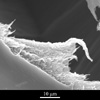Micrograph Library
Browse the libraryAdvanced searchSystemsCompositionsTechniquesKeywordsPhase diagramsHelpPreferencesAbout the micrograph libraryTerms of useContribute micrographs!FeedbackLinksCredits Print this page

Full Record for Micrograph 590

[52 KB]
View micrograph
.. in new window
View micrograph and record
.. in new window
You can also view and download the micrographs on Flickr
- Micrograph no
- 590
- Brief description
- Remnants of crazes on a polycarbonate fracture surface
- Keywords
- craze
 , craze remnants, fibril
, craze remnants, fibril  , fracture
, fracture  , polycarbonate (PC), polymer
, polycarbonate (PC), polymer 
- Categories
- Fracture, Polymer
- System
- Polycarbonate (PC)
- Composition
- Not specified
- Standard codes
- Reaction
- Processing
- Applications
- Polycarbonate is a clear and relatively tough plastic used to make shatterproof windows, lenses and even helmets. It is also used to make compact discs.
- Sample preparation
- The surface has been sputter-coated with gold, to give a conducting surface
- Technique
- Scanning electron microscopy (SEM)
- Length bar
- 10 μm
- Further information
- The fracture surface shows fibrils of oriented polymer which are the remnants of crazes. Crazes are both a precursor to cracking and a toughening mechanism in stressed polymers. They only form when a certain critical tensile stress has been attained and form perpendicular to the largest tensile principal stress. They are very fine crack-like projections from the fracture surface but are bridged by even finer material, giving approximately 50% voids. It is these fibrils which interfere with light in an otherwise transparent polymer to make the crazing visible as a whitening of the strained material. It is the remnants of these fibrils which are visible on this fracture surface.
- Contributor
- J A Curran
- Organisation
- Department of Materials Science and Metallurgy, University of Cambridge
- Date
- 03/10/02
- Licence for re-use
 Attribution-NonCommercial-ShareAlike 4.0 International
Attribution-NonCommercial-ShareAlike 4.0 International- Related micrographs

